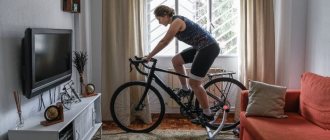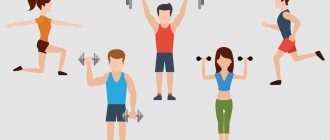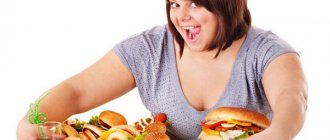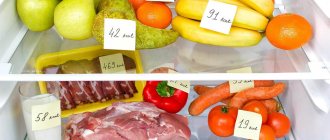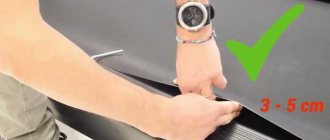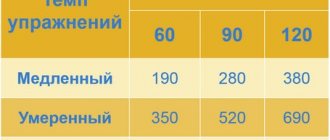How to Increase Your Calorie Burn
Movement is one of the main mechanisms that trigger metabolism. If you don't move, you burn significantly less calories, but there are some additional conditions.
For example, mental activity consumes quite a lot of calories. Therefore, there are differences whether you are sitting and watching a TV series or writing a doctoral dissertation. In the second option, many more calories are burned... maybe that's why there are so few fat scientists?
note
Of course, I would like this world to be extremely simple and understandable, but you need to keep in mind: calories are a rather arbitrary value. The amount indicated by the simulator or indicated in any manual (including this material) is largely arbitrary; in each situation it will be slightly different, and the calories themselves are different. However, this fact is not a reason not to burn calories by training.
In addition, we note the products consumed. The most famous way to burn more calories is to drink cold water, which activates the metabolism, and also requires resources to warm the liquid. Well, spicy food also promotes metabolism.
What are the benefits of walking?
Many are accustomed to thinking that if you get cardio exercise, it must be through running, cycling or skiing. However, walking, just like the exercises listed, strengthens the cardiovascular system, being the most non-traumatic type of activity.
Here are just some of the most noticeable benefits that walking gives your body:
- helps you lose weight or maintain a healthy weight;
- long and fast walks increase endurance;
- helps prevent or manage chronic diseases;
- for people leading a sedentary lifestyle, 20 minutes of walking a day reduces the risk of premature death by 16-30% (American Journal of Clinical Nutrition study);
- for older people, an hour's walk 3 times a week reduces the risk of dementia;
- walking strengthens the heart;
- relieves stress, reduces anxiety;
- Walking as a means of cross-training allows your joints and muscles that are actively involved in running to rest;
- On a rest day from training, walking is an effective way to burn fat and increase blood flow for muscle recovery.
Walking up the stairs
You might look a little weird if you start walking up your own stairwell, but this is one of the easiest and most affordable ways to burn calories. And you shouldn't make excuses for not having a gym membership.
Choose motivational music or an audiobook for an hour, then go walking up the stairs.
How many calories are burned by walking in 1 hour?
If you want to burn more calories and lose weight faster, it is, of course, better to opt for running.
However, walking also provides many health benefits and helps you maintain a healthy weight. Running will require twice as many calories as walking. However, if after running you eat a portion twice as large as usual, you should not expect weight loss.
A man weighing 72 kg will burn 300 calories in an hour of walking at a speed of 5.5 km/h. When running at a speed of 8 km/h, the same man will burn 600 calories. To achieve results in losing excess weight, we recommend combining these two types of exercise.
For example, the author of this article does not use transport if the desired destination is 3 km away or if there is a trip with transfers: you can walk to the stop from where you can leave directly. In addition, sometimes during evening traffic jams it is much faster and more pleasant to walk home or an intermediate stop than to hang on the handrail in a crowded bus.
For owners of personal vehicles, the recommendation is this: do not use your car for short distances. There are several advantages here: health benefits, no need to look for parking, saving on gasoline, reducing the load on road infrastructure. Walking is environmentally friendly!
Don't forget that it's not just your walking speed that affects the amount of energy you consume. Walking uphill will require much more calories than walking on the plain. You can find a hilly area outside or set the incline on your treadmill to 5%. Gradually increase the incline to maximum, usually 15%.
Despite all the obvious benefits of walking, you still have to watch your diet if you want to lose weight. At the National Laboratory. Lawrence Berkeley (USA) collected data from more than 15,000 walkers and 30,000 runners to determine which group lost weight more effectively.
The study found that runners were generally able to control their weight more effectively and were overall slimmer. One likely reason for this is the aftereffect of intense exercise, which increases metabolic rate and increases calorie consumption for 14 hours after activity. There is no such afterburning of calories in walking.
Another reason runners lose weight better is because of their post-workout caloric intake. In a study published in the Journal of Obesity, researchers found that walkers were more likely to overeat than runners after a 60-minute workout.
After the training, all study participants were invited to a buffet where they could choose their dishes. The walkers ate 50 more calories than they burned during exercise, while the runners ate 200 fewer calories than they burned during exercise. Runners were also found to have higher levels of peptide YY, a blood hormone that suppresses appetite. This was not observed among pedestrians.
Exercise bike or cycling
Quite a pleasant workout option that allows you to burn the right amount of calories. The bicycle activates mainly the muscles of the legs - the largest and most massive. Also, leg exercises are the best for kickstarting your metabolism.
The best option would be interval training, that is, alternating light and heavy loads. If we are talking about cycling, then it is useful to choose a changing landscape in which the heights alternate and periodically you need to ride at different inclinations.
A complete list of various physical activities and calorie consumption levels
So, below is a table of calorie expenditure for various physical activities.
| Activity (calorie expenditure) | per 1 kg of weight | for 80 kg weight | for 70 kg weight | for 60 kg weight | for 50 kg weight |
| Running up the steps | 12,9 | 1029 | 900 | 771 | 643 |
| Ice-skating race | 11,0 | 880 | 770 | 660 | 550 |
| Running (16 km/h) | 10,7 | 857 | 750 | 643 | 536 |
| Ballet classes | 10,7 | 857 | 750 | 643 | 536 |
| Construction of snow fortresses, snowmen | 10,1 | 811 | 710 | 609 | 507 |
| Cross country running | 8,6 | 686 | 600 | 514 | 429 |
| Water polo | 8,6 | 686 | 600 | 514 | 429 |
| Swimming fast crawl | 8,1 | 651 | 570 | 489 | 407 |
| Running up and down the steps | 7,7 | 617 | 540 | 463 | 386 |
| Cycling (20 km/h) | 7,7 | 617 | 540 | 463 | 386 |
| Jumping rope | 7,7 | 617 | 540 | 463 | 386 |
| Water aerobics | 7,6 | 606 | 530 | 454 | 379 |
| Strength training on machines | 7,4 | 594 | 520 | 446 | 371 |
| Field hockey | 7,0 | 560 | 490 | 420 | 350 |
| Badminton (fast pace) | 6,9 | 554 | 485 | 416 | 346 |
| Running (8 km/h) | 6,9 | 554 | 485 | 416 | 346 |
| Handball | 6,9 | 554 | 485 | 416 | 346 |
| High intensity dancing | 6,9 | 554 | 485 | 416 | 346 |
| Skiing | 6,9 | 554 | 485 | 416 | 346 |
| Dancing to the disco rhythm | 6,9 | 553 | 484 | 415 | 346 |
| Wood sawyer job | 6,9 | 549 | 480 | 411 | 343 |
| Swimming (2.4 km/h) | 6,6 | 526 | 460 | 394 | 329 |
| Gymnastics (vigorous) | 6,5 | 520 | 455 | 390 | 325 |
| Mountaineering | 6,5 | 518 | 453 | 388 | 324 |
| Football | 6,4 | 514 | 450 | 386 | 321 |
| Striptease | 6,0 | 480 | 420 | 360 | 300 |
| Ashtanga yoga | 6,0 | 480 | 420 | 360 | 300 |
| Race walking | 5,9 | 475 | 416 | 357 | 297 |
| Bricklayer's work | 5,7 | 457 | 400 | 343 | 286 |
| Disco dancing | 5,7 | 457 | 400 | 343 | 286 |
| Basketball | 5,4 | 434 | 380 | 326 | 271 |
| Games with a child (high activity) | 5,4 | 429 | 375 | 321 | 268 |
| Diving | 5,1 | 411 | 360 | 309 | 257 |
| Water skiing | 5,1 | 406 | 355 | 304 | 254 |
| Cycling (15 km/h) | 4,6 | 366 | 320 | 274 | 229 |
| Digging up beds | 4,6 | 366 | 320 | 274 | 229 |
| Fruit picking | 4,6 | 366 | 320 | 274 | 229 |
| Modern dancing | 4,6 | 366 | 320 | 274 | 229 |
| Table tennis (singles) | 4,5 | 360 | 315 | 270 | 225 |
| Walking (at a speed of 5.8 km/h) | 4,5 | 360 | 315 | 270 | 225 |
| Rollers | 4,4 | 354 | 310 | 266 | 221 |
| Wood chopping | 4,3 | 343 | 300 | 257 | 214 |
| Pulling out last year's grass | 4,3 | 343 | 300 | 257 | 214 |
| Medium intensity charging | 4,3 | 343 | 300 | 257 | 214 |
| Cycling (at a speed of 14 km/h) | 4,3 | 343 | 300 | 257 | 214 |
| Work as a massage therapist | 4,2 | 336 | 294 | 252 | 210 |
| Playing with children with walking and running | 4,0 | 321 | 281 | 241 | 201 |
| Playing with your child (moderate activity) | 4,0 | 321 | 281 | 241 | 201 |
| Window cleaning | 4,0 | 320 | 280 | 240 | 200 |
| Ballroom dancing | 3,9 | 314 | 275 | 236 | 196 |
| Plumbing cleaning | 3,9 | 314 | 275 | 236 | 196 |
| Downhill skiing | 3,9 | 309 | 270 | 231 | 193 |
| Walking (6 km/h) | 3,9 | 309 | 270 | 231 | 193 |
| Cleaning glass and mirrors | 3,8 | 303 | 265 | 227 | 189 |
| Badminton (moderate pace) | 3,6 | 291 | 255 | 219 | 182 |
| Volleyball | 3,6 | 291 | 255 | 219 | 182 |
| Horse riding | 3,6 | 291 | 255 | 219 | 182 |
| Walking with children in the park | 3,6 | 286 | 250 | 214 | 179 |
| Figure skating | 3,6 | 286 | 250 | 214 | 179 |
| Gymnastics (light) | 3,4 | 274 | 240 | 206 | 171 |
| Work of a carpenter or metal worker | 3,4 | 274 | 240 | 206 | 171 |
| Hiking (4 km/h) | 3,4 | 269 | 235 | 201 | 168 |
| Easy cleaning | 3,4 | 274 | 240 | 206 | 171 |
| Weeding new weeds | 3,3 | 263 | 230 | 197 | 164 |
| Walking (at a speed of 4.2 km/h) | 3,1 | 251 | 220 | 189 | 157 |
| Low intensity dancing | 3,1 | 246 | 215 | 184 | 154 |
| Rowing (4 km/h) | 3,0 | 240 | 210 | 180 | 150 |
| Swimming (0.4 km/h) | 3,0 | 240 | 210 | 180 | 150 |
| Fencing | 3,0 | 240 | 210 | 180 | 150 |
| Shopping | 3,0 | 240 | 210 | 180 | 150 |
| Table tennis (doubles) | 2,9 | 234 | 205 | 176 | 146 |
| Cleaning carpets with a vacuum cleaner | 2,9 | 234 | 205 | 176 | 146 |
| Household chores | 2,9 | 232 | 203 | 174 | 145 |
| Playing the guitar while standing | 2,9 | 231 | 202 | 173 | 144 |
| Lawn mowing | 2,9 | 229 | 200 | 171 | 143 |
| Walking the dog | 2,9 | 229 | 200 | 171 | 143 |
| Slow dancing (waltz, tango) | 2,9 | 229 | 200 | 171 | 143 |
| Bathing a child | 2,7 | 215 | 188 | 161 | 134 |
| Carrying small children in your arms | 2,7 | 215 | 188 | 161 | 134 |
| Canoeing (4 km/h) | 2,6 | 211 | 185 | 159 | 132 |
| Cycling (9 km/h) | 2,6 | 211 | 185 | 159 | 132 |
| Shoemaker's work | 2,6 | 206 | 180 | 154 | 129 |
| Walking (4 km/h) | 2,6 | 206 | 180 | 154 | 129 |
| Bookbinder's work | 2,4 | 194 | 170 | 146 | 121 |
| Walking with a stroller | 2,2 | 173 | 151 | 129 | 108 |
| Piano playing | 2,2 | 173 | 151 | 129 | 108 |
| Gymnastic exercises | 2,1 | 171 | 150 | 129 | 107 |
| Hiking (3.2 km/h) | 2,1 | 171 | 150 | 129 | 107 |
| Sex (active) | 2,1 | 171 | 150 | 129 | 107 |
| Machine control | 2,1 | 171 | 150 | 129 | 107 |
| Buying groceries | 2,1 | 171 | 150 | 129 | 107 |
| Ironing clothes (standing) | 2,1 | 166 | 145 | 124 | 104 |
| Hair Styling | 2,0 | 161 | 141 | 121 | 101 |
| Ride a motorcycle or scooter | 2,0 | 161 | 141 | 121 | 101 |
| Playing with children while sitting | 2,0 | 161 | 141 | 121 | 101 |
| Feeding and dressing the baby | 2,0 | 161 | 141 | 121 | 101 |
| Washing dishes | 2,0 | 160 | 140 | 120 | 100 |
| Typing on the keyboard at a fast pace | 2,0 | 160 | 140 | 120 | 100 |
| Typing on a computer | 2,0 | 160 | 140 | 120 | 100 |
| Gardening | 1,9 | 154 | 135 | 116 | 96 |
| Gardening | 1,9 | 154 | 135 | 116 | 96 |
| Mopping floors | 1,9 | 149 | 130 | 111 | 93 |
| Bed making | 1,9 | 149 | 130 | 111 | 93 |
| Mopping floors | 1,9 | 149 | 130 | 111 | 93 |
| Stretching | 1,8 | 144 | 126 | 108 | 90 |
| Knitting | 1,7 | 137 | 120 | 103 | 86 |
| Dressing and undressing, fitting | 1,7 | 137 | 120 | 103 | 86 |
| Singing | 1,7 | 137 | 120 | 103 | 86 |
| Fishing | 1,7 | 137 | 120 | 103 | 86 |
| Hand sewing | 1,6 | 126 | 110 | 94 | 79 |
| Reading aloud | 1,6 | 126 | 110 | 94 | 79 |
| Working at the computer | 1,4 | 115 | 101 | 87 | 72 |
| Walking with family | 1,4 | 115 | 101 | 87 | 72 |
| Car driving | 1,4 | 115 | 101 | 87 | 72 |
| Playing guitar while sitting | 1,4 | 115 | 101 | 87 | 72 |
| Eating while standing | 1,3 | 106 | 93 | 80 | 66 |
| Dressing/Undressing | 1,3 | 106 | 93 | 80 | 66 |
| Personal hygiene | 1,3 | 106 | 93 | 80 | 66 |
| Taking a shower | 1,3 | 106 | 93 | 80 | 66 |
| Talking while eating | 1,3 | 106 | 93 | 80 | 66 |
| Traveling by plane | 1,3 | 105 | 92 | 79 | 66 |
| Office work | 1,2 | 99 | 87 | 75 | 62 |
| Dusting | 1,1 | 91 | 80 | 69 | 57 |
| Cooking food | 1,1 | 91 | 80 | 69 | 57 |
| Dusting | 1,1 | 91 | 80 | 69 | 57 |
| Classroom lesson, lesson | 1,1 | 91 | 80 | 69 | 57 |
| Writing letters | 1,1 | 91 | 80 | 69 | 57 |
| Talking on the phone while standing | 1,1 | 91 | 80 | 69 | 57 |
| Reading poetry and prose in front of an audience | 1,1 | 91 | 80 | 69 | 57 |
| Lying awake | 1,1 | 88 | 77 | 66 | 55 |
| Sex (passive) | 1,1 | 86 | 75 | 64 | 54 |
| Sedentary work | 1,1 | 86 | 75 | 64 | 54 |
| Cooking food | 1,1 | 86 | 75 | 64 | 54 |
| Ironing clothes while standing | 1,0 | 80 | 70 | 60 | 50 |
| Making the bed | 0,9 | 69 | 60 | 51 | 43 |
| French kiss (kcal per one) | 0,9 | 69 | 60 | 51 | 43 |
| Taxi ride | 0,7 | 57 | 50 | 43 | 36 |
| Card game | 0,7 | 57 | 50 | 43 | 36 |
| Playing board games | 0,7 | 57 | 50 | 43 | 36 |
| Talking on the phone while sitting | 0,7 | 57 | 50 | 43 | 36 |
| Family dinner, conversation at the table | 0,7 | 57 | 50 | 43 | 36 |
| Passionate kiss (kcal per one) | 0,7 | 57 | 50 | 43 | 36 |
| Eating while sitting | 0,7 | 54 | 47 | 40 | 34 |
| Taking a bath | 0,7 | 54 | 47 | 40 | 34 |
| Sitting with a child on your lap | 0,7 | 54 | 47 | 40 | 34 |
| Ironing clothes while sitting | 0,6 | 46 | 40 | 34 | 29 |
| Light kiss (kcal per one) | 0,4 | 34 | 30 | 26 | 21 |
| Reading books while sitting | 0,4 | 33 | 29 | 25 | 21 |
| Dream | 0,6 | 51 | 45 | 39 | 32 |
To get the exact value, you need to multiply the indicator from the first column by your body weight.
Badminton
Of course, there are many other sports options, but badminton is especially interesting and here’s why:
- Now in many cities there are quite a few sections and equipped spaces for classes;
- minimal equipment is required, you can train almost anywhere;
- the classes are easy and do not require special training;
- The sport requires constant movement, which unobtrusively burns a lot of calories.
For losing weight and burning calories, badminton is almost an ideal option. This sport is pleasant to do; physical activity in this version is enjoyed even by people who are not particularly active, and at the same time it really gives an excellent load to the whole body.
What muscles work when walking?
At a slow walking pace of less than 5 km/h, muscle activity is minimal. Power walking starts at 6 km/h. At this pace, the legs, hips, and knees are actively strengthened. The abdominal and arm muscles are used to a lesser extent; the core muscles act as a stabilizer.
When walking uphill, a good load is placed on the quadriceps, gluteus maximus and calf muscles.
Nordic walking, in addition to those already mentioned, uses the muscles of the cervical-brachial region, pectoral and scapular muscles, triceps and biceps.


